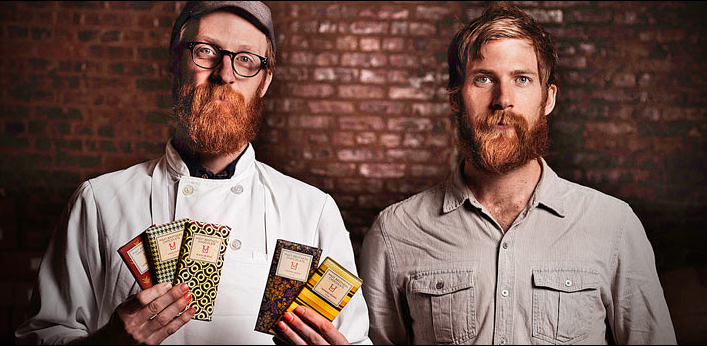2016: One Year Of Craft Chocolate In Review
What a year!
Between major political changes and technological breakthroughs, 2016 has been an interesting year. For many, one to forget. For others, one that taught important lessons.
Lucky us, there was always something there to ease our days: craft chocolate.
It was definitely a year dedicated to educating consumers. Sure, craft chocolate professionals have spent many years doing so. But THIS YEAR the message had high chances to really come across.
Big manufacturers were losing money. Consumers were looking for quality products. Transparency and sustainability were on everybody's mouth. It was craft chocolate's turn to shine!
Online and offline media got curious about the subject. Countless articles have been written about craft bean-to-bar chocolate. Information wasn't always accurate, but it got readers interested. Companies from all over the world (especially from the US) received a great deal of PR coverage as well.
New chocolate makers appeared on the scene. With samples in their pockets, they traveled the world to gather feedback and precious advice. You could find them at festivals and events talking to the experts or checking out chocolate equipment. The enthusiasm kept them positive in spite of the challenges and the competition.
2017 has all the premises to be an amazing year for craft chocolate. But to understand what's coming next, we ought to look back to realize what just happened.
Here are the highlights of an exciting 2016 for craft chocolate.
MAST BROTHERS
Mast Brothers were exposed in December 2015, but the consequences of the scandal still echoed throughout 2016. In every discussion about bean-to-bar chocolate, the bearded brothers are still used as the evil comparison. "Not like some hipsters in Brooklyn", chocolate professionals giggle.
Rick (left) and Michael Mast from Mast Brothers chocolate.
On one side, they are credited for introducing the big public to craft bean-to-bar chocolate. On the other side, lies and poor quality didn't help setting good standards for the industry. Nonetheless, they are still on everybody's mouth.
ALTERNATIVE SWEETENERS
A sugar dilemma fired up the craft chocolate industry in 2016.
Concerned for their health, consumers started demanding alternatives. Chocolate makers tried them all: coconut sugar, honey, stevia, fruit pulp, panela. The challenge was to satisfy picky consumers while staying true to the intrinsic flavor of prestigious cacao. Companies also introduced chocolate bars with high cacao percentages (80-90%) as well as 100% alternatives with creamy textures and crunchy inclusions like cocoa nibs.
BELIZEAN AND TANZANIAN CACAO
Chocolate makers are always on the hunt for new cacao to work with. In 2016, they found their treasures in Central America and East Africa.
In Belize, they had Emily Stone and her team from Maya Mountain Cacao providing well-fermented and socially sustainable cacao. In Tanzania, Simran and Brian founded Kokoa Kamili and managed to finally provide flavorful African cacao.
Dozens of chocolate bars from these two origins started appearing on the market. Every maker gave a personal touch so that consumers could enjoy distinctive flavors despite the common source.
BIG CHOCOLATE LOSING MONEY
2016 was not a bright year for big chocolate manufacturers like Hershey's and Cadbury. Their financial statements showed massive losses from the previous years.
These companies paid the price of questionable practices, like using cheap vegetable oils or reducing the sizes of their products. Certifications, re-designed packages and the use of craft chocolate terms didn't help their already damaged reputations. This was great news for craft chocolate makers! Disappointed by the big distribution, consumers could finally develop an interest towards better chocolate.
FERMENTATION TALKS
Great chocolate comes from great beans. And great beans are well-fermented beans. This is why fermentation is always a hot topic in the chocolate industry. It is the magical step that makes cocoa beans usable for chocolate production. But the paradigms of a "good fermentation" are being recently challenged.
Fermentation helps cacao develop its distinctive chocolaty flavor.
The younger generation of chocolate makers is not afraid of disrupting the old "80% standard". They believe that fermentation is not a technical step anymore, but can rather become a creative process. Especially in 2016, talks around fermentation were extremely relevant. During festivals, events and conferences, fermentation was always the center of attention.
BEAN-TO-BAR IS TRENDY IN EUROPE
In the US, bean-to-bar chocolate is an established market. But in the land of Swiss chocolatiers and high-end patisserie, 2 ingredient chocolate found its challenges. Thanks to the influence from oversea, also the demanding palates of the old continent developed an interest for bean-to-bar chocolate.
Many European chocolatiers and pastry chefs now want to make their own chocolate, and look up to their US counterpart to establish their businesses. In 2016, a satisfying selection of craft chocolate could be found also in Europe: The Chocolate Tree in Scotland, Friis-Holm in Denmark, Utopick Chocolate in Spain, Omnom Chocolate in Iceland, Malmo Chokladfabrik in Swedish, and many more.
LARGER BASE OF CRAFT CHOCOLATE LOVERS
In 2016, craft chocolate found amazing online support. Instagrammers, bloggers, photographers, food writers. The enthusiasm about craft chocolate spread all over Social Media platforms where the finest chocolate was shared and appreciated. The word of mouth served as free marketing and advertising.
Also chocolate tasting courses, factory tours, dedicated festivals and educational events found great fortune this past year. The excitement around craft chocolate was palpable. There is no stopping in 2017 for craft chocolate. In the next year, we will be likely to see: hazardous flavor combinations, unexpected places of origin, cacao farmers selling their own chocolate, a vast range of dairy-free options, questionable moves from big manufacturers, and much, much more.
Get excited!
What are your best chocolate memories from 2016?



